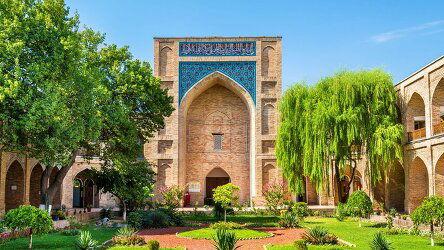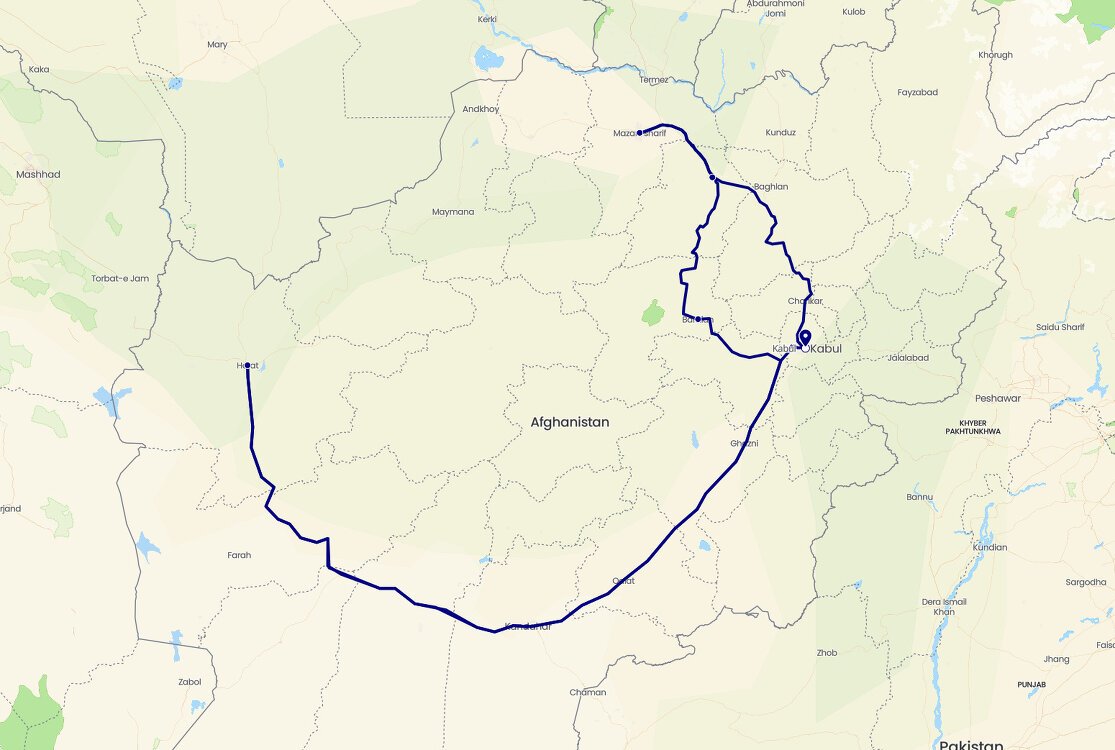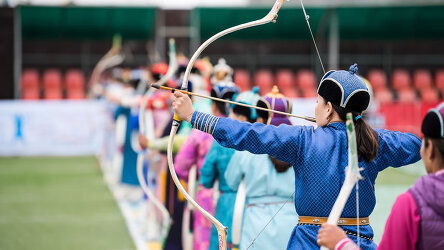Overview
It is a place of legendary hospitality to guests and legendary hostility to invaders. Any trip here is an adventure. Sights like the remains of the giant Buddhas of Bamyian, the unreal blue of the lakes at Band e Amir or...read more the first sight of the almost unreachable Minaret of Jam are incredible but most peoples lasting memories of Afghanistan will be something on a more human scale. Kite flying kids, drinking tea with ex-mujahedin or walking with catapult wielding Hazara children. A trip to Afghanistan offers the opportunity to see a country that has been off the tourist map for decades, to visit a place that is starkly beautiful and to interact with people and places that you probably only know from news reports.
Itinerary
Welcome to Afghanistan! Upon arrival, you will be met and transferred to your hotel. For those who arrive early, you will have time to take an afternoon tour of the city. This will include a visit to the Old City, the remains of Darulaman Palace and a visit to the Kabul Museum. Afghanistan's capital first received an influx of foreign tourists in the late 1960's when it became an essential stop-off on the hippy trail towards enlightenment. Chicken Street was the home of cheap hotels and souvenir shops. Chicken Street is still here, selling souvenirs to aid workers, although the Chickens have now gone and the hotels are not so cheap. Much of the rest of the city has changed beyond recognition in the last 30 years, new buildings in the city centre, promising signs of post-invasion reconstruction give way to rubble and ruins on the outskirts. Yet there are occasional outbreaks of tranquillity.
Many mosques and mausoleums remain standing, as do the lush Gardens of Babar, and the European Cemetery, the final resting place of the great Silk Road explorer Auriel Stein. With the UN and NGO agencies in residence, the parts of Kabul with pizza restaurants and shops with western goods have a feel unlike anywhere else in the country. There is little left of ancient Kabul although the city walls and the Bala Hissar (sadly off limits and used by the Afghan military) still stand to give a glimpse into the past. There are also plenty of interesting places revealing the Kabul of today. The Omar land mine museum is a sobering introduction into some of Afghanistan's more modern history. The Old City is not so old any more, much of it bombed during the Afghan civil war. The bazaar however retains much of the feel of old Kabul, modern goods now mixing with the ancient.
For those who are early risers, you may see stall owners setting up and preparing their fresh goods for the day, at Ka Faroushi bird market there all types of birds on display and for sale, and by Kabul river, witness avid photographers still working with old box cameras.
This morning is yours to explore Kabul. You may visit places such as the British cemetery, the bush bazaar and Babur's Gardens.
From here, you are transferred to the airport for your flight to the city of Mazar-e Sharif, one of the largest cities in Afghanistan. Only a short drive from the ancient Silk Road city of Balkh, it is home to many of Afghanistan's ethnic Uzbeks and during Nau Ruz, the Persian new year, the town becomes packed full of pilgrims. In the 12th century a local Mullah had a dream that the final resting place of Ali, the cousin and son-in-law of Mohamed was not in Najaf, modern day Iraq, but in this town where he once lived. Meaning ‘Noble Shrine' or ‘Tomb of the Exalted', the shrine and indeed the town of Mazar-e Sharif exist as they do because of this. The original 12th century shrine was destroyed by Genghis Khan and much of what is on display today has been restored over the years. Once checked into your accommodation, the day is yours at leisure. (B)
This morning after breakfast, visit the holiest place in Afghanistan for both Shia and Sunni Muslims, the blue tiled tomb of Hazrat Ali. The shrine is constantly surrounded by flocks of white pigeons, and local legend has it that if a black pigeon joins the flock, within a month it will have turned white.
Continue on to the ancient silk road city of Balkh, known as Bactria to the Greeks and Umm Al-Belaad (Mother of Cities) to the Arabs. Balkh was once the capital of this fertile area watered by the rivers running down from the Hindu Kush and the Pamirs. Explore the cities 4000 year history including the blue tiled shrine of Khoja Parsa, 1500 year old Buddhist Stupas, No Gombad Mosque (the oldest in Afghanistan) and the tomb of Baba Koo-i-mastan (the holy man who first refined hashish) as some of its highlights. It is also the birthplace of Zoroaster, the founder of the Zoroastrian religion, and the renowned poet Rumi was also born here. Overnight in Mazar. (B)
Today you will visit the 1500 year old remains of the Buddhist monastery in Samangan, approx. two hours drive south of Mazar-e Sharif. The complex dates from the 4-5th century and contains a number of caves carved out of the bedrock which were used as places of worship. The area is known as Takht e Rostam (Throne of Rostam), named after the leading protagonist of an ancient Persian legend. The local folklore tells the tale of Rostum meeting his own estranged son, Sohrab, on the battlefield and when he refuses to identify himself, they fight with Rostum killing Sohrab. This doesn't seem to affect Rostum too much as he continues with his adventures with seemingly little remorse.
In keeping with Buddhist tradition the stupa should be circumnavigated in a clockwise direction. En route you will also be able to visit Tashkurgan and the old king's hunting lodge. (B)
This morning, transfer to the airport and return to Kabul. Enjoy the day exploring Kabul, visiting the sobering OMAR landmine museum, the Murad Khane district, and the ‘Mosque of the King of Two Swords', Shah-e Doh Shamshira mosque, located on the banks of the Kabul river. Construction began during the 1920's, and under Amanullah Khan's push for modernisation, it features an Italian baroque style and features a two storey design, making it one of the most unusual Islam mosques in the world. (B)
Today visit the Panjshir Valley, proudly described by locals as the most beautiful place in Afghanistan. Here you will view the tomb of Ahmed Shah Massoud, Afghanistan's most universally revered Mujahedin commander, known as the Lion of Panjshir. You will also have the chance to sample some of the local cuisine at a local fish restaurant on the banks of the Panjshir River.
Panjshir, means ‘five lions', and legend has it that the lions were 5 protectors who defended the valley for Mahmood of Ghazni in the 12th century. Famous as an emerald mining area and home to the largest concentration of ethnic Tajiks in Afghanistan, it was also the base of Ahmed Shah Massoud, the lion of the Panjshir. His tomb is located at the beginning of the valley, and his poster can be seen throughout Afghanistan as he is considered the most famous mujahedin leader from the soviet war, often referred to as ‘our national hero'. (B)
Today you will transfer to the airport bound for Bamiyan, ‘the place of shining light'. It is the capital of the Hazarajat, home of the Hazaras, and one of the most peaceful places in Afghanistan. Bamiyan Valley marked the most westerly point of Buddhist expansion and lying on the silk road, was a crucial hub of trade. It was a place where East met West and its archaeology reveals a blend of Greek, Chinese, Turkish, Indian and Persian influences.
Marvell at the large numbers of caves carved into the cliffs overlooking the town, in which Buddhist monks once lived and worshiped. They were often highly decorated with Buddhist motifs including large statues of Buddha. Bamiyan's giant Buddah statues, carved into the sandstone cliff face, were completed in the 6th century AD and stood 37m and 55m high respectively, making them the highest standing Buddha statues in the world for almost 1500 years. The Buddhas fell into disrepair when Buddhism in this region was replaced by Islam in the 11th century.
The legs of the largest Buddha were destroyed by the Mughal emperor Aurangzeb in the 17th century, and in the 18th century, the Persian Nadir Shah fired canons at them. Despite this they remained standing until March 2001 when the Taliban used artillery, anti-tank mines and finally dynamite to destroy the Buddhas. Even without the Buddhas themselves, the valley of Bamiyan is spectacular, the ruins of 2 forts guard the entrance to the valley and at sunset the rock takes on a beautiful reddish hue. It is also possible to climb into the caves and view the valley from where the largest Buddha's head would have been. (B)
You will have three days to explore in and around Bamiyan, an area of striking natural beauty. The mountains and valleys are dotted with ruins from Afghanistan's past as well as friendly Hazara villages.
Visit Band-i-Amir, consisting of a group of 5 lakes, the area is also called the ‘Pearl of the Desert' because of its fantastically beautiful coloured waters, which change with the reflection of the moving sun across the sky. Whilst geologists have shown that they are natural dams resulting from mineral deposits, legend has it that the lakes were created by Ali, the cousin and son-in-law of the prophet Mohamed. It is possible to swim in the lakes and in the summer we can arrange boat trips and overnight stays in yurts on the lakes edge.
Explore the beauty of Dragon Valley. According to legend, when a village maiden was offered as a sacrifice to the dragon, a hero named Hazrat Ali fought the dragon and cut it in half from head to tail. The dragon shed tears of repentance. The split back of the dragon fell apart and created the Bamiyan valley and ‘the tears', originating from a natural spring, are still flowing down the valley today.
See the ruins dating back to the 6th century of Shahr e Zohak, the ‘Red Fort', an old fortress of the Shansabani dynasty located at the junction of the Bamiyan and Kalu rivers. It was destroyed in the invasion of Genghis Khan in the 12th century.
Despite the grim history of Shah e Golghola, ‘The City of Screams', the panoramic view of Bamiyan valley from the top of the forts ruined parapets is a sight to behold. (B)
Today transfer to the airport and return to Kabul, taking the opportunity to visit any sights you may have missed in the Afghan capital. (B)
This morning take an early flight to Herat. The afternoon is yours at leisure to enjoy the city.
“Stretch a leg in Herat and you'll poke a poet in the ass”, so says an ancient Farsi saying. The poets may be thinner on the ground these days but Herat's history as a centre of culture remains and it boasts the best concentration of ancient buildings in Afghanistan. The skyline at sunset is sublime with minarets and domes peaking out over the rooftops. In many ways Herat has more in common with its Persian neighbours in Iran than Kabul on the other side of the Hindu Kush and has been fought over for millennia due to its strategic position and agricultural wealth of the surrounding valley. Tamerlane made Herat his capital in 1381 and the minarets of the Mussallah complex still remain from the Timurid rule. From June to September Herat can sometimes get caught up in the ominously named ‘bad-i-sad-o-bist-roz', the ‘wind of 120 days'. However, this wind is a welcome relief from Herat's equally notorious summer heat. (B)
Herat has the largest collection of ancient buildings in Afghanistan and you will have a full day to explore the city and its surroundings including the Friday Mosque, the Tomb of Gawhar Shad, the Masullah Complex and the atmospheric shrine of Khoja Ansari at Gazar Gah. (B)
Boarding a morning flight to Kabul, you will have this last opportunity explore the city, including a visit to the many shops of Chicken Street. (B)
Following breakfast, you have time at leisure until your transfer to the airport for your onward departure. (B)
Trip Inclusions
- Discover the ancient silk road city of Balkh
- Visit the 1500 year old remains of the Buddhist monastery in Samangan
- Explore Panjshir Valley, proudly described by locals as the most beautiful place in Afghanistan
- Marvel at the large numbers of caves carved into the cliffs overlooking Bamiyan, in which Buddhist monks once lived
- Visit Band-i-Amir, aka ‘Pearl of the Desert’ due to its fantastically beautiful coloured waters
- Return airport transfers
- 12 nights accommodation
- 12 Breakfasts
- 6 domestic flights (Kabul-Mazar/Mazar-Kabul, Kabul-Herat/Herat-Kabul & Kabul-Bamiyan/Bamyian-Kabul)
- Air conditioned transportation with English speaking local guides
- Sightseeing as per the itinerary
- Entrance fee to all attractions as per itinerary
- Afghanistan visa invitation letter
- International flights
- Visas
- Travel and medical insurance
- All services, meals other than those indicated above
- Any changes to the proposed and confirmed program.
- All items of a personal nature e.g. drinks, laundry, telephone calls, tips etc
- Any additional flights needed in Afghanistan that may be necessary due to security concerns
- Accommodation, itinerary and inclusions subject to change.
- Disruptions to itinerary may occur.
Prices & Dates
There are currently no departures available on this trip. Either it's the end of the season and new departures will be released shortly, or this itinerary has been changed and will no longer continue. Feel free to contact us for information about when next seasons dates will be released or click here to view the general release dates for all destinations.
Tour & cruises prices are per person. Prices shown have savings applied, are subject to availability and may be withdrawn at any time without notice. Prices and trip information are correct at the time at this point in time, however are subject to confirmation at the time of booking and are subject to change by Crooked Compass. For cruise itineraries, cabin images are sourced from Crooked Compass. These should be treated as indicative only. Cabin inclusions, upholsteries and room layout may differ to the image(s) shown depending on the ship selected and your sailing dates.
Similar Tours

16 Days Ulaanbaatar Almaty
Operated By: Crooked Compass

15 Days Tashkent Dushanbe
Operated By: Crooked Compass

14 Days Chengdu Luang Prabang
Operated By: Crooked Compass






